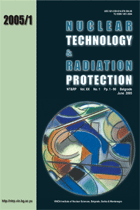
ELECTROCHEMICAL STUDIES ON STRESS CORROSION CRACKING OF INCOLOY-800 IN CAUSTIC SOLUTION
Part I: As received samples

June 2005
UDC 621.039+614.876:504.06
YU ISSN 1451-3994
....Back to Contents
Pages: 74 - 80
Authors: Alice DINU, Manuela FULGER, Dragos IONESCU, Lucian VELCIU, and Maria RADULESCU
AbstractMany non-volatile impurities accidentally introduced into the steam generator tend to concentrate on its surface in restricted flow areas. In this way these impurities can lead to stress corrosion cracking (SCC) on stressed tubes of the steam generator. Such impurities can be strong alkaline or acid solutions. To evaluate the effect of alkaline concentrated environments on SCC of steam generator tubes, the tests were conducted on stressed samples of Incoloy-800 in 10% NaOH solution. To accelerate the SCC process, stressed specimens were anodically polarised in a caustic solution in an electrochemical cell. The method of stressing of Incoloy-800 tubes used in our experiments was the C-ring. Using the cathodic zone of the potentiodynamic curves it was possible to calculate the most important electrochemical parameters: the corrosion current, the corrosion rate, and the polarisation resistance. We found that the value of the corrosion potential to initiate the SCC microcracks was -100 mV. The tested samples were examined using the metallographic method. The main experimental results showed that the increase of the stress state promoted the increase of the SCC susceptibility of Incoloy-800 samples tested under the same conditions, and that the length of the SCC-type microcracks increased with the growth of the stress value.
Key words: alkaline SCC, Incoloy-800, accelerated tests
FULL PAPER IN PDF FORMAT (1.18MB)
Last updated on September, 2010